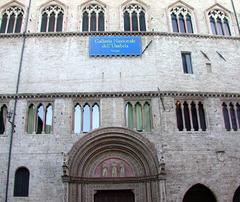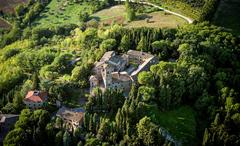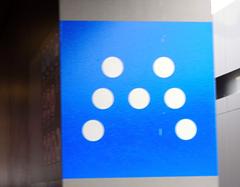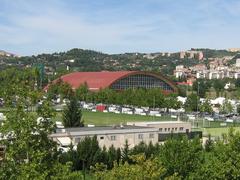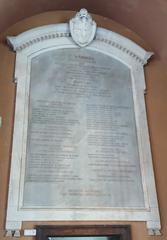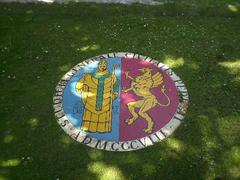
National Gallery of Umbria Perugia: Visiting Hours, Tickets, and Historical Sites Guide
Date: 14/06/2025
Introduction
Nestled in the heart of Perugia, Italy, the National Gallery of Umbria (Galleria Nazionale dell’Umbria) is a premier destination for art and history enthusiasts. Housed in the iconic Palazzo dei Priori, this museum curates an exceptional collection that chronicles the evolution of Umbrian and Italian art from the 13th through the 19th centuries. Since its establishment in 1878, following the secularization of ecclesiastical art post-Italian unification, the gallery has become a cornerstone of regional and national heritage, offering visitors an immersive journey through masterpieces of painting, sculpture, goldsmithing, and decorative arts (official website, Perugia tourism).
The National Gallery of Umbria is not only a treasure trove of artistic achievements by luminaries such as Perugino, Pinturicchio, Piero della Francesca, and Duccio di Buoninsegna; it is also intimately woven into Perugia’s civic identity. The gallery’s spaces, thoughtfully modernized within the medieval Palazzo dei Priori, host educational programs, special exhibitions, and collaborations with cultural festivals like Umbria Jazz, fostering vibrant community engagement (Finestre sull’Arte).
This guide provides detailed information on visiting hours, ticketing, accessibility, travel tips, and highlights nearby historical sites, ensuring a rewarding experience for every visitor (umbriatourism.it, whichmuseum.com).
Historical Development
Origins and Evolution
The roots of the National Gallery of Umbria date to 1863, when religious orders were suppressed and their artworks transferred to public institutions. Officially established in 1878 within the Palazzo dei Priori, the gallery’s collection has grown through acquisitions, donations, and reorganization, reflecting the ongoing commitment to preserving and presenting Umbrian cultural heritage (official website).
Role in Italian Art History
Serving as the foremost showcase of the Umbrian School, the gallery highlights artists such as Perugino—teacher of Raphael—Pinturicchio, Piero della Francesca, Benozzo Gozzoli, and Duccio di Buoninsegna. Its collections offer insight into the transition from the Middle Ages to the Renaissance and beyond (Perugia tourism).
Key Milestones
- 1863: Foundation of the collection post-suppression of religious orders
- 1878: Official opening in Palazzo dei Priori
- 20th Century: Expansion, reorganization, and modernization
- Recent Years: Technological upgrades and enhanced educational outreach
Architectural Significance: Palazzo dei Priori
Historical Context and Features
The Palazzo dei Priori is a masterpiece of medieval civic architecture, begun in 1293 and extended into the 15th century. Its Gothic façade, crenellated battlements, and heraldic details (griffin and Guelph lion) symbolize Perugia’s independence and civic pride. Inside, visitors find vaulted halls, original frescoes, wooden ceilings, and adjacent spaces such as the Hall of Notaries and Collegio del Cambio, all contributing to the museum’s historical ambiance (official Perugia tourism, official website).
Adaptive Reuse and Modernization
Careful restoration has preserved the building’s integrity while introducing modern amenities—climate control, lighting, and accessibility—to meet the needs of contemporary visitors. Exhibition spaces progress chronologically, offering a seamless narrative through centuries of art.
Collection Highlights & Artistic Legacy
Chronological and Thematic Organization
The gallery’s 39 rooms are arranged to narrate the evolution of Umbrian art, from religious medieval works and goldsmithing to Renaissance masterpieces and Baroque paintings. Thematic rooms include reconstructed chapels and interactive displays, immersing visitors in the cultural context of each era (official website).
Masterpieces and Notable Artists
- Perugino: Extensive collection demonstrating his serene compositions and use of perspective (official website).
- Pinturicchio: Richly detailed narrative works.
- Duccio di Buoninsegna, Fra Angelico, Piero della Francesca: Key pieces marking artistic transitions.
- Sculpture & Decorative Arts: Notable works by Agostino di Duccio and exquisite goldsmithery (Goldsmithery at GNU).
Educational and Cultural Role
The museum promotes research, public education, and accessibility through thematic displays, rotating exhibitions, and outreach programs (Perugia tourism).
Essential Visitor Information
Location and Access
Located at Corso Pietro Vannucci 19, in Perugia’s historic center, the gallery is easily accessible by foot and public transport from major city landmarks (umbriatourism.it, artsupp.com).
Visiting Hours
- Monday: 12:00 – 19:30
- Tuesday to Sunday: 08:30 – 19:30
Check the official website for updates and holiday variations (whichmuseum.com).
Tickets
- General Admission: €8–€10
- Reduced (EU citizens 18–25): €5
- Free: Under 18, Perugia residents, other qualifying groups
- Purchase tickets online or at the entrance; advance booking is recommended during peak periods.
Accessibility
The gallery is fully accessible, with elevators, ramps, wheelchairs available, Braille captions and tactile models for visually impaired visitors, and a child-friendly Baby Pit Stop. Guide dogs are allowed.
Visitor Facilities
- Bookshop & Library: Art books, souvenirs, and a specialized art history library.
- Restoration Workshop: Occasionally open to the public.
- Modern Restrooms & Cloakroom
- Interactive Multimedia: Digital displays and audio guides are available in multiple languages (viadelvino.com).
Artistic Collection: Highlights by Period
Medieval and Renaissance Masterpieces
- Duccio di Buoninsegna’s Madonna and Child (Duccio at GNU)
- Perugino’s Adoration of the Magi, Decemviri Altarpiece (Perugino at GNU)
- Piero della Francesca’s Polyptych of Sant’Antonio (Piero della Francesca at GNU)
- Fra Angelico’s Guidalotti Polyptych (Fra Angelico at GNU)
- Gentile da Fabriano’s Madonna and Child with Saints (Gentile da Fabriano at GNU)
Umbrian Primitives and Local Schools
Works by Niccolò di Liberatore (l’Alunno), Benedetto Bonfigli, Bartolomeo Caporali, and others exemplify the diversity of regional styles.
Sculpture and Decorative Arts
Agostino di Duccio’s Reliefs from the Oratory of San Bernardino (Agostino di Duccio at GNU), and the Reliquary of Sant’Ercolano (Goldsmithery at GNU).
16th–19th Century Highlights
- Baroque: Orazio Gentileschi’s Martyrdom of St. Lawrence (Baroque at GNU)
- 19th Century: Paintings by Annibale Brugnoli and Domenico Bruschi
Thematic Rooms
Explore the Sala dei Notari, Chapel of Priors, dedicated rooms for Perugino, and the Treasury (Gallery Map and Rooms).
Travel Tips & Nearby Attractions
- Combine your visit with Perugia’s other sites: Collegio del Cambio, Hall of Notaries, Capella di San Severo, Fontana Maggiore, and Rocca Paolina.
- Public transport and parking are available nearby.
- Family-friendly: Interactive displays, baby facilities, and workshops for children.
- Cafés and shops line Corso Vannucci for refreshments and local crafts.
Special Programs, Exhibitions, and Community Engagement
The gallery offers guided tours (book via Sistema Museo: Tel. 075 5721009), educational workshops for all ages, lectures, painting and photography classes, and regular temporary exhibitions—including the 2024–2025 “L’età dell’oro” on the use of gold in art (Umbria Tourism). Collaborations with festivals and international institutions enhance its role as a vibrant cultural hub (Finestre sull’Arte).
Digital Access
For those unable to visit in person, explore the gallery’s virtual tour and digital collection online.
Frequently Asked Questions (FAQ)
Q: What are the National Gallery of Umbria’s visiting hours?
A: Monday 12:00 – 19:30; Tuesday to Sunday 08:30 – 19:30. Check the official website for updates.
Q: How much do tickets cost?
A: €8–€10 for adults; €5 for EU citizens 18–25; free for under 18s and Perugia residents. Buy tickets online.
Q: Is the gallery accessible?
A: Yes, with elevators, ramps, accessible restrooms, Braille captions, and guide dog access.
Q: Are guided tours available?
A: Yes, bookable through Sistema Museo (Tel. 075 5721009).
Q: Is photography allowed?
A: Non-flash photography is permitted except where signage indicates otherwise.
Q: What else can I see nearby?
A: Collegio del Cambio, Hall of Notaries, Capella di San Severo, and Perugia’s historic center.
Conclusion and Call to Action
The National Gallery of Umbria is an essential stop for anyone interested in Italian art and history. With its rich collections, accessible visitor services, and central location among Perugia’s historic sites, it provides a deeply rewarding experience. For the latest updates, guided tour bookings, and multimedia guides, download the Audiala app and explore our related content on Perugia’s cultural highlights.
Plan your visit, discover centuries of artistic achievement, and immerse yourself in the vibrant heritage of Umbria at the National Gallery of Umbria (official website).
References
- National Gallery of Umbria: Visiting Hours, Tickets, and Exploring Perugia’s Historical Sites, 2025, Official Website
- Artistic Collection and Highlights, 2025, Perugia Tourism
- Cultural and Visitor’s Guide to the National Gallery of Umbria: Hours, Tickets, and Educational Impact, 2025, Finestre sull’Arte
- Visiting the National Gallery of Umbria: Hours, Tickets, and Must-See Artworks in Perugia, 2025, Umbriatourism.it
- Raphael’s Umbrian Roots, 2024, Italy Magazine
- L’età dell’oro Exhibition, 2024, Umbria Tourism
- Museums in Perugia, 2025, Musei a Perugia
- Exploring Umbria, 2025, Exploring Umbria
- National Gallery of Umbria Visitor Information, 2025, WhichMuseum

